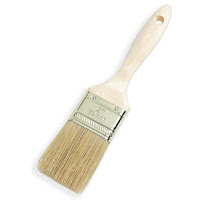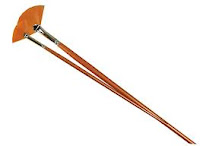
Thursday, August 29, 2013
Acrylics and WATER
Water for Painting
No, painting with acrylics is not like painting with water colors, but it still can be quite similar. Water is used to give paint a more smooth stroke, and to make acrylics less clumpy if it happens to be that way. Acrylics don't need much water to wash the paint off your brush, since you can simply use a napkin to wipe the paint off, but washing your brush when you want to change colors can be beneficial to a wonderful painting. It also depends on how you look at your colors. I paint, but I don't wipe ALL the color off my brush at times, because a blue with a hint of leftover black from your brush can create a cool effect, or pink with a hint of purple from your brush. Looks amazing, really.
Saturday, August 10, 2013
Wednesday, July 24, 2013
Saturday, July 20, 2013
Friday, July 19, 2013
Tuesday, July 9, 2013
Underpainting
Underpainting is basically adding an opaque color to the base of the painting; much like building the foundation of a building before constructing the building itself. Usually a thin layer of white is added to the pre-draw on the canvas. Just filling in the spaces and outlining the lines. Then you can layer on other colors, mostly blue or purple to show lighting. The final layer is the real colors of the subject. Experiment with underpainting and it can transform amateurish paintings into a bit more like the professional ones.
Translucent and Opaque
Without an underpainting, acrylics can become translucent a bit. Like the colors yellow, pink, and blue can all become quite translucent. Great for painting windows and glass, but maybe not so much when it comes to painting other subjects. To fix this problem you can add an opaque color to the translucent color, like adding white to yellow or black to blue. The color will change, so if a change in color is not of your preference then be sure to do an underpainting. I will explain underpainting in the next post.
Texture
Acrylic Paint is well known for it's outstanding texture. You can use acrylic paint to add texture to bark on trees, rocks in riverbeds, grass, and leaves. Acrylic can also be very smooth, just add a bit of water or acrylic medium and you'll be able to create smooth, gentle strokes perfect for painting the portrait or adding smaller details to a painting.
Friday, June 28, 2013
Acrylic Paint, Why??
Why Acrylic???
Acrylic paint is a bold, dashing, bright and less smelly paint. No one likes smelly paint and I doubt you do either. Acrylic also dries fast, so your paintings are finished faster! Faster is better right?
Okay here are the pros and cons of Oil Paint and Acrylic Paint. Acrylics have way more pros than oils do. So go with acrylic, it's obvious that they're better.
Acrylic
Pros:
- dries faster
- bright colors
- bold strong colors
- easy to apply
- does not stick like glue
- can wash off your hands easily with soap
- not overly smelly; smells like...well, paint
- way cheaper, and comes in bigger bottle for less prices
Cons:
- stains clothing, uhhh, what paint doesn't stain clothing?
- dries up if not capped
Oil Paint
Pros:
- bright colors
- very strong, eye-catching colors
- comes in a large variety of different shades and tints
- more paint-like texture
Cons:
- smelly, extremely
- comes in tiny tubes, enough for a painting? Nah.
- expensive!!!
- sticks to paintbrushes like glue!
- kills your paintbrushes, literally
- stains clothing, like any other paint
- sticks to your hands for 3 days, hard to wash off even with soap!
So which is better? Depends on your opinions I guess. But for me, I'm sticking with acrylic. This is my opinions on things, so if you disagree; write your own blog.
Working With Your Brush
The Brush is A Part of You
The brush is not a force to be reckoned with, it's a force to be worked with. Think of the brush as a part of you, a part of your hand, and a part of your mind.
Forcing the brush to move paint around the canvas is not going to get you anywhere. For paint to flow smoothly, especially acrylic, add a bit of water; then the brush can easily move the paint around to where you want it to go. Practicing different strokes with one brush is a wonderful way to get to know how a brush works.
Tip: Animal Hair brushes are very, very messy and can cause little hairs to fall into the paint on your painting. No one I know wants to spend most of their painting time picking little hairs out of their masterpieces. It's not fun.
Instead: Go with the synthetic hair brushes. They usually have white, soft, plastic looking hairs.
Animal Hair Brushes
The hairs tend to fall out all the time.
Synthetic Hair Brushes
Please go with these brushes, they last longer and are less hard to handle.
The Brush
The Artist Brush or Brushes
Brushes come in a wide variety of shapes and sizes. Mostly you can do just fine with one brush, but it's nice to have a variety to create many different styles of art in one painting.
The Large Bristle Brush
This brush may be used to paint only backgrounds, but can also be used to create an entire painting all on it's own, preferably landscapes.
I mainly use this brush for painting grassy landscapes and covering canvases with a primer.
The Small Round Brush
This brush comes in very handy when you're painting small details or photo-realistic paintings. I can live on this brush alone for my artwork since both my landscapes and main subject require a lot of details.
The Fan Brush
The Fan brush is a optional paintbrush I suppose, since I mainly use this brush for only waterfalls, but it also depends on your style of painting. If you're the type of artist who loves broad, smooth strokes then this brush is a great tool to have.
Feel free to explore the possibilities and the extent of painting with any brush. Most art stores sell beginner packets of brushes and sponges for very affordable prices, around the ranges of $5-$10.
Thursday, June 27, 2013
Starting a New Hobby
Acrylic Painting
Painting has been a form of communicating emotions throughout history. Traditional art, art that requires no form of electronics, has been slowly replaced by the more advanced art forms of digital media. Acrylics and Oil paints are more than just "old fashioned"; they can do more, especially since newer colors and textures have emerged. Welcome to tavaloveschocolate's blog, a place where all young artists can come to learn amazing techniques on how to work with their brush, bring out colors, and express their thoughts through painting.
Subscribe to:
Comments (Atom)






